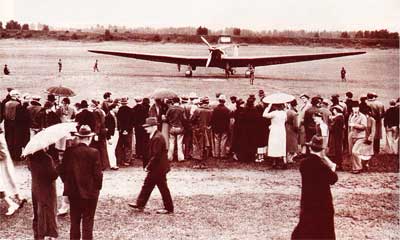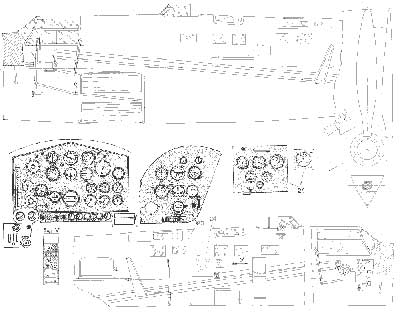Tupolev ANT-25 Soviet Long Range Record Setter
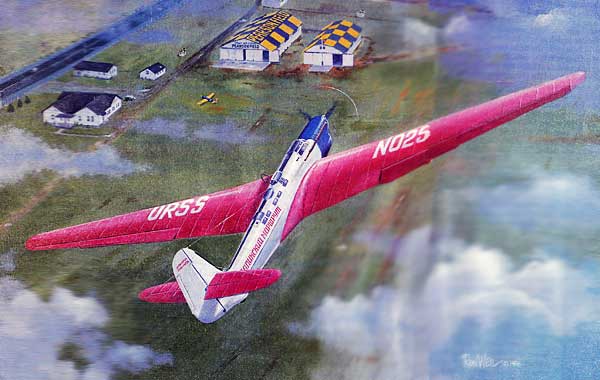
The Soviet Union was also attracted by the challenge of long-distance flights and in 1934, on 10-12 September, a Tupolev ANT-25 broke the world closed-circuit distance record, covering 7,712 miles in 75 hours 2 minutes; on 18-20 June 1937, the first nonstop f1ight from Moscow to Portland, Oregon, was made, a distance of 5,284miles covered in 63 hours 25 minutes. A month later the ANT-25 set a new long-distance record, flying from Moscow to San Jacinto, California, a distance of 6,303 miles in 62 hours 17 minutes.
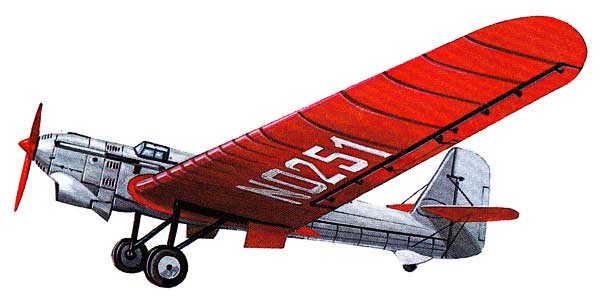
Tupolev ANT-25
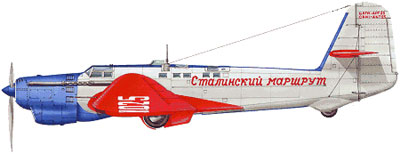 The ANT-25 was designed as the result of a recommendation by Kliment Voroshilov to the Revolutionary Military Council Revvoyensovyet on 7 December 1931, to build an aircraft for long range flights.
The aircraft was designed by the brigade of the Experimental Aircraft Design Department of TsAGI lead by Pavel Sukhoi under the overall supervision of Andrei Tupolev.
The ANT-25 was designed as the result of a recommendation by Kliment Voroshilov to the Revolutionary Military Council Revvoyensovyet on 7 December 1931, to build an aircraft for long range flights.
The aircraft was designed by the brigade of the Experimental Aircraft Design Department of TsAGI lead by Pavel Sukhoi under the overall supervision of Andrei Tupolev.
The first prototype, designated Experimental airplane RD-1, (also designated TsAGI-25, ANT-25), RD standing for Rekord Dalnosty, i.e. "Range Record") made its maiden flight on June 22, 1933, piloted by Mikhail Gromov and used a direct drive M-34 engine. The first crew, Gromov, Filin and Spirin, began with a long range test flight in September 1934 on the second prototype, the RD-2. The RD-2 used a geared M-34R engine, which substantially increased its range. They spent 75 hours in the air, covering 7,712 mi in a single trip, (Moscow - Ryazan -Tula - Dnepropetrovsk - Kharkov). The aircraft was unable to return to Moscow due to a fuel shortage. Gromov was made a Hero of the Soviet Union. The flight was not recognized as a world record as it could not complete the circuit to Moscow, so could not claim the closed circuit record, while the direct distance between Moscow and Kharkov was too short for the distance in a straight line record.
Gromov and Yumashev decided to make their next long-range flight an attempt at the straight-line record. They wanted to fly the traditional long-range route via Africa and the Atlantic Ocean to South America. A crewman, Sigismund Levanevsky, on studying some maps, suggested they fly in a completely different direction – to the north. Polar aviators were extremely popular at that time, his plan was considered plausible. The flight was cancelled in the spring of 1935 when he fell seriously ill. The next long range flight planned, was from Moscow to the USA via the North Pole. A
sloping concrete runway 2.5 mi in length, was built at Schelkovo air-base near Moscow. In the early morning of August 3, 1935, Levanevsky, Baidukov and Levchenko climbed aboard their RD and took to the air. For the first 31 mi, the aircraft ascended to only 1,600 ft. They then steadily increased their altitude to 16,000 ft, maintaining an average speed of 165 kilometers per hour 103 mph. After approximately 1,200 mi, an oil leak was discovered but the aircraft was able to make an emergency landing at Krechevits near Novgorod. Levanevsky was called to a Politburo meeting, where he blamed Tupolev, declaring that his single-engined ANT-25 was under-powered. It seemed to be the end for the aircraft.
His second pilot Georgy Baidukov, who was also an aviation engineer, disagreed and proposed Valery Chkalov for a second attempt. Chkalov was at first skeptical about his selection, as he was a fighter pilot with little navigational knowledge. Baidukov briefed Chkalov on the finer points of flying the ANT-25 and proposed Aleksander Belyakov, who was the chief instructor of their flight academy, as their third crewman. Chkalov's authority was enough to convince Stalin.
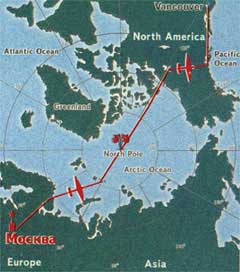 Flight Path from Moscow to Vancouver on June 18-20, 1937. |
In July 1936, the record was broken by Chkalov, Baidukov and Belyakov flying the same aircraft from Moscow to the Far East (Stalin's Route) in 56 hours 20 minutes; a distance of 5,825 mi. They passed Franz Josef Land - Severnaya Zemlya - Tiksi - Yakutia - Petropavlovsk-Kamchatsky - Khabarovsk - Okhotsk Sea and landed on a beach at Udd island (now called Chkalov island), near the Amur River.
The next day, Pravda newspaper published a leading article "Glory to Stalin's Sokols!" A wooden runway was constructed on Udd island and on August 2 , the ANT-25 departed for Moscow. The trip back lasted a week with stops at Khabarovsk, Chita, Krasnoyarsk and Omsk with a grand welcome at each. Chkalov's trio became Heroes of the Soviet Union. Two islands nearby were renamed after Baidukov and Belyakov.
Chkalov's achievement became world-famous, however, the Politburo still wanted the publicity of a direct flight. Gromov was ordered to fly to Brazil on August 14, 1936 in a second ANT-25, but as he prepared for the start on 25 September, Brazilian officials denied access to the Soviet plane and the flight was cancelled. Both Chkalov's and Gromov's crews were now destined to fly north from Moscow to San Francisco.
Over June 18-20, 1937 - the same crew of Valery Chkalov, co-pilot Georgy Baidukov and navigator A. Belyakov made a non-stop flight from Moscow to Portland, United States, in bad weather. At the 60 hour point they passed Seattle, after two more hours they passed Portland lighthouse on the Columbia River and headed deeper into US territory. Over the city of Eugene they found they were short of fuel and turned back for the military airbase at Vancouver, landing at Pearson Airfield. (by the other sources - Barak Airfield). The 5,670 mi trip took 63 hours and 25 minutes. In 1975, an obelisk was erected on the airfield to commemorate this event.
Another widely publicized feat was the Moscow - San Jacinto non-stop flight in a backup aircraft just three weeks after Chkalov's. This journey, via the North Pole, covered 7,100 mi. The crew, still composed of Gromov, Yumashev, and Danilin, flew for 62 hours and 17 minutes between July 12 and 14, 1937. After landing, the aircraft still had sufficient fuel for approximately 930 mi, enough to reach Panama. This would have involved crossing the Mexican border without the permission of FAI sporting officials.
Gromov became an unofficial Soviet Pilot No. 1, Chkalov remained the favourite pilot of the Soviet people. Joy at the achievements were tempered by Levanevsky crashing on the same route in a brand-new 4-engined DB-A.
The record set by the Soviets was broken by two British Vickers Wellesley bombers which flew from Egypt to Australia in November 1938; a distance of 7,160.6 mi. The USSR did not continue the race, aviation design bureau works stalled due to repression. Tupolev was jailed, Gromov was also on the brink of arrest. Chkalov mysteriously crashed while testing a new fighter on December 15, 1938.
After Chkalov's death, Usachoyv, the Chief of the Aviation Industry Directorate Belyaikin and the director of the plant where Chkalov's machine had been built, and Tomashevich, the designer, all came under suspicion due to sabotage. Nikolai Polikarpov escaped arrest.
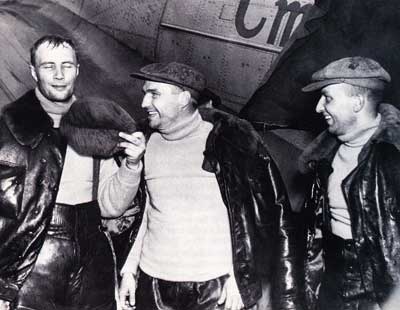 The crew of the Stalin's Route, from left, navigator Belyakov, pilot Chkalov and co-pilot Baidukov, as they arrive at Pearson Field. |
Corporal Charles Alexander was doing what most everyone did during Sunday morning guard duty at the Army Air Corps' Pearson Field in Vancouver, Washington-reading and listening to the radio. Sitting in the drizzle at a small airfield in 1937 was not the most thrilling assignment. If a fellow was lucky, he might see a few Army pilots take a training flight.
Then, a little before 8:30 a.m., a red-winged giant rolled past his guard station. It was no Army trainer, and though Alexander did not know what the words Stalinsky Marshrut ("Stalin's Route")-written on its side in Cyrillic-meant, he had heard about this plane on the radio. Inside were three Russian fliers who had just flown over the North Pole. This rainy June morning in 1937, Alexander knew, was going down in the history books.
The unique hazards of the North Pole meant that it was one of the last natural obstacles conquered by aviators. Flying over the pole had all the perils of a transoceanic flight, with freezing weather, arctic storms and navigation problems thrown in as well. Compasses act up in the pole's magnetic fields, and there were no radio beams to follow.
But the Soviet Union was eager to prove its technological prowess and the superiority of its economic and ideological systems. Soviet dictator Josef Stalin summoned Sigismund Levanevsky and Valery Chkalov to the Kremlin to discuss a transpolar flight in May 1937. Levanevsky was well-known in the West for his aerial feats, including the rescue of American flier Jimmy Mattern in Siberia and a flight from Siberia to Los Angeles over the North Pacific in 1936.
Chkalov was a crack test pilot whose aerobatic high jinks resulted in repeated reprimands, a brief imprisonment and his discharge from the air force (he was later reinstated). But he was a newly minted Communist Party member, and his proletarian roots as the son of a shipyard worker may have made him more palatable to Stalin than the Polish born Levanevsky.
Levanevsky argued for using the four-engine Tupolev ANT-6 (TB-3), reasoning that four engines provided a greater margin for safety on a dangerous transpolar flight. Chkalov pushed the single-engine ANT-25, countering Levanevsky's safety argument by turning it on its head: Four engines, he said, only increased the chance of failure four times.
Stalin selected Chkalov to lead the first attempt at a transpolar flight. Joining Chkalov on the flight were co-pilot Georgy Baidukov and navigator Aleksandr Belyakov. The trio was familiar with the rigors of cold-weather flying, having made a 5,858-mile flight over the desolate arctic reaches of Siberia in 1936, when they landed on tiny Udd Island in their ANT-25. Each of the men was honored as a hero of the Soviet Union for that flight. Still, they did not get credit for breaking the long-distance record set by French fliers Paul Codos and Maurice Rossi on their 1933 flight from New York to Syria (5,657 miles). The Udd Island flight was not validated by the Federation Aeronautique Internationale, the international body that oversaw aviation records.
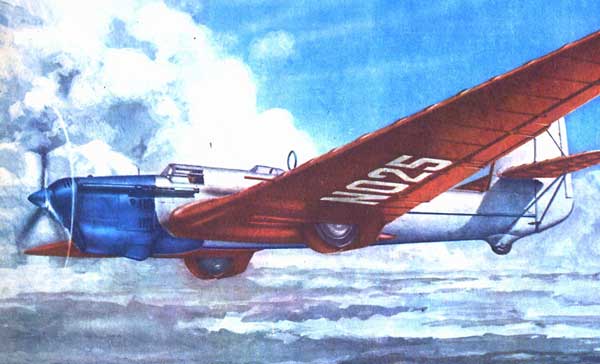
This time, Chkalov and his comrades meant to blaze a path over the pole and set a long-distance record. Their intended destination was Oakland, Calif., about 6,000 miles from their takeoff point at Schelkovo Aerodrome near Moscow.
The ANT-25 had been specifically designed for long-distance flight by Andrei N. Tupolev, whose initials served as the plane's name. It was a metal cantilever monoplane with a varnish-impregnated fabric covering. Its red wings spread 112feet and dwarfed the 44-foot gray fuselage. A Mikulin AM-34R engine in a V-12 configuration with about 750 horsepower turned a geared, three-bladed metal propeller to achieve a top speed of nearly 150 mph. The plane weighed 24,750 pounds fully loaded, including 13,760 pounds of fuel and oil.
Permission to make the flight did not mean that the crew had a free hand on how to proceed. Soviet style bureaucracy meant the fliers had a formidable array of experts to help them prepare-engineers, mechanics, doctors, meteorologists and other technicians. But it also meant that every detail required someone's approval and, often, official authorization from the Kremlin. Inevitably, there were arguments between the pilots and the commissars.
A month's supply of food-255 pounds-was ordered loaded aboard the plane, though only one-tenth of it was required for the three-day flight. Chkalov cursed at Deputy Flight Director Antonov, saying, ''Why the hell do we need so much stuff?" He pointed out, to no avail, that reducing the plane's weight by 220 pounds could mean another 185 miles of flight.
Chkalov argued that carrying parachutes was pointless, since they would be flying either too low to use them or over water or icy wastelands with no chance of rescue. He quit fighting after Antonov told him the real purpose for the chutes was to "show the Americans we have a parachute industry on par with the United States." Politics, according to Chkalov, was another matter.
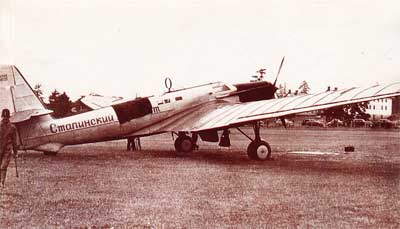 Stalin's Route Parked at Pearson Field. |
The real power, as far as the fliers were concerned, lay with the meteorologists. Their chance to make history with a pole-crossing flight depended on the meteorologists' forecasts. Again and again they were told that the situation was "generally unfavorable" and that permission for the flight could not be granted. The fliers kept their sense of humor, however, and nicknamed chief meteorologist Altovsky "Mr. Cyclone" for his gloomy predictions. Chkalov joked that "the view of weather is like that of beauty: some people like it and others do not." The crew finally received the meteorologists' blessing for a June 18 takeoff. Stalin was personally consulted and gave the go-ahead.
In the wee morning hours of June 18, 1937, Chkalov gave the ANT-25's engine full power. The plane moved reluctantly down the starter hill on the long concrete runway at Schelkovo Aerodrome. The runway had been specially constructed to facilitate takeoffs by overloaded aircraft, but even so, the fence at the end of the runway had been taken down for the departure of the fuel-heavy ANT-25. Chkalov eased the plane airborne, and Baidukov, mindful that many long-distance attempts ended with an overweight plane still on the ground, immediately retracted the landing gear and then hugged the pilot.
The overloaded plane labored to gain altitude. "It seemed like a powerless mountain climber," Baidukov later recalled, "who suddenly would fall off from some steep incline and drop into an abyss."
Less than 10 hours into the flight they faced the first round of a dangerous bout with icing. Baidukov was flying on instruments at 6,500 feet when ice unbalanced the propeller and the plane began to buffet violently. He roused a sleeping Chkalov to operate a hand pump for the de-icing fluid. The fluid worked, and Baidukov increased revolutions to climb out of the clouds whose moisture had caused the icing.
Headed north to the pole, Chkalov, Baidukov and Belyakov flew 10 hours through heavy fog and battled ice that formed nearly 5 inches thick on the leading edges of the wings. They had to climb repeatedly out of the clouds.
Somewhere beyond Franz Josef Land, their radio ceased to receive transmissions. Belyakov continued to radio their status to Soviet stations, but for the next 22 hours they would receive no messages while they flew over the desolation of the Arctic.
As the ANT-25 approached the North Pole, the compasses started acting up, dancing and spinning round with any rolling or pitching of the aircraft. Celestial navigation was now a must. Belyakov interrupted his calculations only to remind the pilot to hold a precise course.
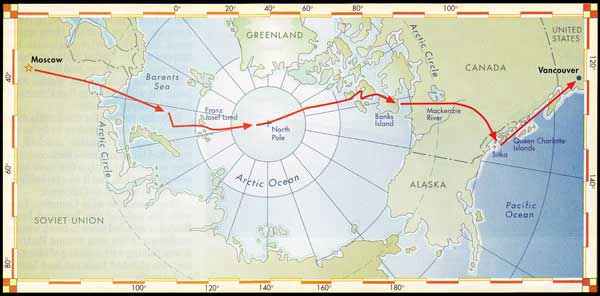
The pilots used the shadow from a large pin placed on the cowling to hold a course. Sensitive to Chkalov's sense of importance, Belyakov gave the pin an important-sounding name. "Guide the aircraft by the solar heading indicator as precisely as you can," he would tell the commander. Baidukov, under strict orders from the navigator to rely only on the "solar heading indicator," marveled that "this silly pin has been elevated to a cult in astronavigation!"
Meanwhile, Soviet authorities were tight-lipped about the flight over the pole. Even as the ANT-25 winged its way across the Arctic on the evening of June 18, Moscow said it was "unaware" of any such attempt. Newsmen and aviation experts were not as credulous as the Kremlin thought, however. They knew that the Soviets had landed four planes on a polar ice floe in May to setup a weather station. And the U.S. Department of State had disclosed in June that it had given permission for a Soviet aviator to fly over U.S. territory. Stories about a "mystery plane" on a polar flight went to press, and now the Soviets' aerial assault on the pole was front-page news.
The crew of the ANT-25 crossed the pole without fanfare. Chkalov slept through it, in fact. Belyakov sent a message: "We have crossed the pole-a tail wind-white ice fields with crevices and expanses of open water-our mood is cheerful." Baidukov aimed the plane, with the help of the shadow from the solar heading indicator, down the 123rd meridian toward the United States.
Flying at 18,700 feet, the ANT-25 was near its ceiling. Ahead, clouds that rose another 2,500 feet would cover the plane with ice. The de-icing fluid was gone by that time, so the fliers descended until they found open air between two layers of clouds at just under 10,000 feet.
Then the engine coughed, something splashed on the windshield, and the unmistakable smell of engine coolant filled the cockpit. Baidukov surmised that the pipe that vented the cooling system had frozen over, increasing pressure and rupturing the coolant tank. He screamed at the others to act quickly, for they had only minutes before the engine would overheat and seize up, necessitating a forced landing in the empty wastes of the Arctic.
Baidukov found that the auxiliary coolant tank was empty and lowered the engine revolutions to a minimum. Belyakov and Chkalov cut open the rubber bags holding their emergency water supplies, but they could collect only a few liters from the ice. Suddenly inspired, Baidukov called for the ''balloons" that held urine samples for the medical commissariat. The mixture of water and urine revived the cooling system. The tank had not exploded, and on reflection, the three remembered there was a reduction valve and concluded that it had worked loose and expelled the coolant.
The terrifying prospect of a forced landing in the uninhabited reaches of the Arctic now gave way to nagging doubt. Were they really following the 123rd meridian, they wondered, or had they gotten off course over the pole? Below them, the high-cliffed islands and brown land with ravines and rivers looked remarkably like the Soviet Union's Kola Peninsula. On the other hand, they could be over Greenland. Relief came when Belyakov's sextant readings showed them on course over Banks Island, north of the Canadian mainland.
|
The worst of their journey seemed to be over. They sailed toward Canada in clear skies, passing near Cape Parry, then over the Great Bear Lake at about 125 miles per hour. "The weather was excellent, you couldn't ask for better visibility," Baidukov recalled, "and so it was very simple to navigate and keep on course."
On entering Canada, they had achieved their primary objective-to fly from Europe to North America over the pole. Stalin himself had urged them to think of their safety first and not to take any chances pursuing a long-distance record.
The beautiful weather quickly deteriorated as the plane neared Fort Norman, in the North-West Territories, on the Mackenzie River. To the south, a bleak wall of storm clouds promised more icing, and night was approaching. Belyakov suggested an alternative route-to dash across the Rocky Mountains with what little oxygen they had left, then follow the Pacific coast southward at lower altitudes.
They pushed the ANT-25 to its maximum altitude in hopes of avoiding any peaks and flew over clouds that broke only occasionally to reveal rugged mountains below. Extended flight time in the thin air at nearly 20,000 feet affected the men. The burly Chkalov struggled to pump oil, thick with cold, from the auxiliary tank. He became dizzy and had to wear an oxygen mask to complete the vital task. Baidukov, the youngest of the three at 30, found it difficult just to lie in a sleeping bag. And when it was time to relieve Chkalov at the controls, he found himself almost unable to do so.
It got worse as they ran out of oxygen. Chkalov's nose bled, Baidukov was dizzy and Belyakov was too weak to crawl to the cockpit with a map. Chkalov and Baidukov took one-hour turns at the controls. Finally, near Sitka, Alaska, they broke through to the coast.
Now free from the rigors of the arctic cold and ice, the crew turned their attention to wringing all the distance they could from their remaining fuel. Much precious fuel had been used fighting head winds, avoiding storms and detouring to the coast. They crept over the Queen Charlotte Islands at an airspeed of only 85 mph.
Belyakov managed to fix the radio-one of the fliers had knocked a connection loose in the fuselage-but they were receiving only English-language transmissions. They had expected a numerical code to be broadcast in North America, and none of the three understood English. Soviet engineers had mapped out the United States' system of radio beacons, however, and Belyakov got a fix on the Bellingham, Wash., radio beam. "It will lead us to San Francisco," he told a happy Chkalov.
Belyakov radioed for the Seattle radio beacon and told Baidukov to fly by the radio compass. Chkalov checked the main fuel tanks and came back convinced they were empty. Only a few more hours of flight were left, and it was probably impossible to make it to California.
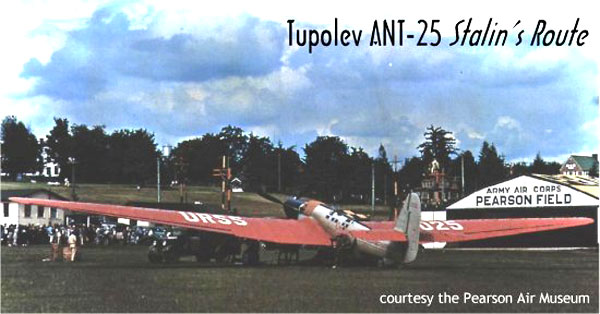
They found the wide Columbia River with the help of the Portland beam. Baidukov spiraled down to check weather conditions in the area around Portland. It was raining with a ceiling of about 800 feet. He climbed back out and headed to the south.
South of Portland, near Eugene, Ore., the fliers became alarmed when fuel pressure began to drop abruptly. They turned back toward Portland. At 8 a.m. on June 20, the fliers sent a message: "Pump does not work-will land in Portland." Learning this, hundreds of aviation buffs and newsmen swarmed into Swan Island Airport, on the banks of Portland's Willamette River.
Baidukov picked his way through the clouds and fog. Breaking through the mist over Swan Island, Chkalov saw the crowd and waved Baidukov off. "Too many people," Chkalov said, "they'll tear our plane apart for souvenirs!" Holding a map in Baidukov's face, he continued, "The military airport in Vancouver is where we will land." The fliers knew about the Army Air Corps' Pearson Field, located at Vancouver Barracks, because it had hosted a Soviet aircraft eight years earlier when a twin-engine ANT-4 (TB-1), Land of the Soviets, had undergone repairs there. Leaving behind a disappointed throng in Portland, the fliers crossed the Columbia River and made a pass over Pearson Field. Baidukov lined up on the west end of the airport. Their glider like plane, its fuel tanks nearly empty, was light and refused to set down. Rapidly running out of room to land, Baidukov switched off the ignition. He recollected later that as the plane rolled along he looked out the cockpit and saw a "guard standing near a hangar, drenched by the rain, becoming quite excited." It was 8:22 a.m. They had been flying nonstop for 21/2 days, and all Baidukov could think of was, "Where do I park?"
Chkalov climbed out of the plane while Baidukov and Belyakov worked inside. The commander was surprised to be greeted in Russian. A University of Washington Reserve Officers' Training Corps student, George Kozmetsky, happened to be walking by at the time and acted as translator. Chkalov asked for wheel chocks and, after securing the plane, a telephone or telegraph. But the world was already on its way to Pearson Field.
Brigadier General George C. Marshall, the commander of Vancouver Barracks, was preparing for breakfast when an aide burst in and breathlessly exclaimed, "The Russians have landed!" Marshall hustled into his Packard and ordered the driver to speed straight across the post golf course to the airfield.
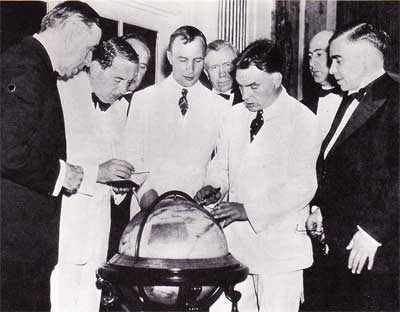 The Stalin's Route crew autographing a globe that bears the names of other pioneering airmen, in New York City, June 30, 1937. |
Inside the plane, Belyakov and Baidukov were aware of the gathering crowd. Chkalov began beating on the side of the fuselage, telling the pair to hurry because "General Marshall" was waiting for them. A puzzled Baidukov saw "a tall, stern-looking man" outside the plane. "Is it a general or a marshal that's meeting us?" he asked Belyakov. Belyakov answered that it must be a general, as he did not think there were any marshals in the United States.
The general returned home with what his wife Katherine later described as "three polar bears." The fliers were furnished with rooms and baths, as well as the cognac they requested. The Marshall family's breakfast of orange juice, bacon, eggs and coffee went to their unexpected guests. Chkalov traced out their route on the family atlas.
Marshall faced the first of a long day of minor and major emergencies when the orderly announced that there were "$100 bills blowing all over the rooms and I don't want to be responsible." The three Russian fliers' supplies included American currency, and they had simply left the bills on the dressers when they went to bathe. As a result, several hundred dollars were blown out the windows and onto the general's lawn.
Soon there were pressmen and curious civilians all over the post. Most of the reporters had been up all night, anticipating a landing somewhere between Seattle and San Francisco, and now they jammed the Marshalls' home. Katherine Marshall compared them to a "pack of wolves ... hungry for food and hungry for news." She sated their hunger with ham, bread, a big GI pot of coffee and any bits of news she could scare up.
Soviet Ambassador Aleksandr Troyanovsky flew up from the consulate in San Francisco. Congratulatory telegrams came in from Stalin, President Franklin D. Roosevelt and others, and the general's telephone rang endlessly. Major Paul Burrows, the field commander, received a more businesslike telegram from the U.S. War Department: "Request, report to this office any data obtainable on instruments used by the Russians on their recent flight to the U.S. especially on navigational instruments. This considered secret."
Two of the three barographs, instruments that show whether a plane has landed during a trip, were still working and were forwarded to aeronautical authorities, who determined the plane had flown 5,288 miles before landing. The flight had not established a nonstop distance record, however, and the fliers expressed regret at not having been able to fly the plane all the way to California.
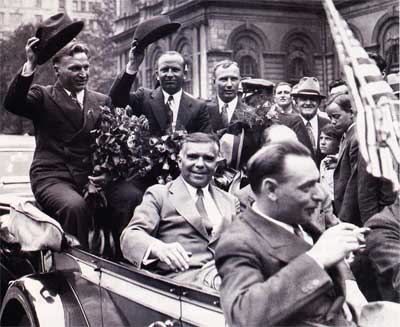 The ANT-25 crew and Arctic colleagues drive by the Explorer Club at New York's Waldorf-Astoria on June 30, the crew are perched on the back of the car. |
But it was still an impressive achievement. It was among the most dangerous flights ever completed. "All this excitement seems strange now," recalled Katherine Marshall just 10 years later, ''but at that time this flight across the pole was considered little short of a miracle."
The flight also suggested intriguing possibilities. Soviet, radio engineer A. Vartanian, in charge of the flight's communications in North America, explained to reporters: "It is a direct route they followed. It will establish a commercial route if not a passenger route." Vartanian's comments were rather optimistic considering the wariness with which the Soviet Union and the United States regarded each other at the time.
The fliers were feted in Vancouver and Portland before boarding a United Airlines flight for San Francisco. They toured the United States and met with President Roosevelt. Their ANT-25 was dismantled by civilian mechanics, crated and shipped on the Norwegian freighter Beranger to Le Havre, France. The plane was later exhibited at the 1937 International Air Fair in Paris.
Soviet aviators continued to take on the challenge of the Arctic. Three weeks after Chkalov's ANT-25 landed at Vancouver, its sister ship successfully flew over the North Pole. With the advantage of their comrades' experience in the Arctic and more favorable weather, the plane made it all the way to San Jacinto, Calif. Pilot Mikhail Gromov, with crewmen Sergei Danilin and Andrei Yumashev, set a nonstop distance record of 6,306 miles.
Levanevsky flew over the pole in his ANT-6 in August, only to disappear. He and his crew were never found. Vladimir Kokkinaki tried to fly nonstop from Moscow to New York via Iceland in April 1939 but had to ditch his Ilyushin DB-3 bomber in New Brunswick, Canada. It was the last Soviet long distance attempt.
In the United States the airmen and their daring flights were quickly forgotten. But back in the Soviet Union they were admired just as much as Charles Lindbergh and Wiley Post in the United States. When Chkalov was killed while testing a new plane in 1938, he was buried in Red Square at the Kremlin wall, with Stalin serving as a pallbearer. Baidukov and Belyakov both rose to the rank of general during long careers.
In 1974, 37 years after Corporal Alexander watched a big, red-winged plane roll past his guard station, the officers from the Soviet trawler Posyet visited Pearson Field. Their hosts, embarrassed that no monument commemorated the historic landing, decided to build one.
Against the backdrop of the Cold War, Georgy Baidukov and Aleksandr Belyakov were among those present to watch as a monument to their achievement was unveiled on June 20, 1975, at Pearson Field.
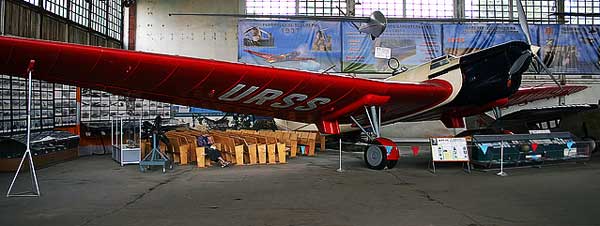
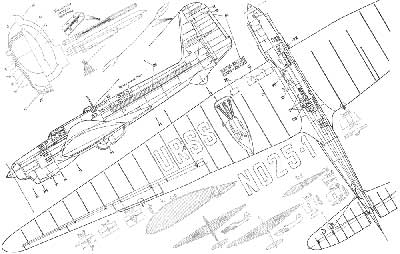 |
|
Click images to enlarge. |
|
Specifications for Tupolev ANT-25
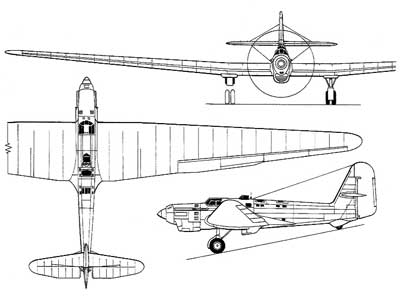 |
Crew: 3 Length: 45 ft 7 in Wingspan: 111 ft 7 in Height: 18 ft 1 in Wing area: 946.15 ft² Empty weight: 9,259 lb Max takeoff weight: 25,353 lb Powerplant: 1× Mikulin AM-34, 750 hp (later forced to 874 hp) at 1,760 rpm for cruise Performance Maximum speed: 130 mph Range: 8,078 mi Service ceiling: 22,966 ft |


